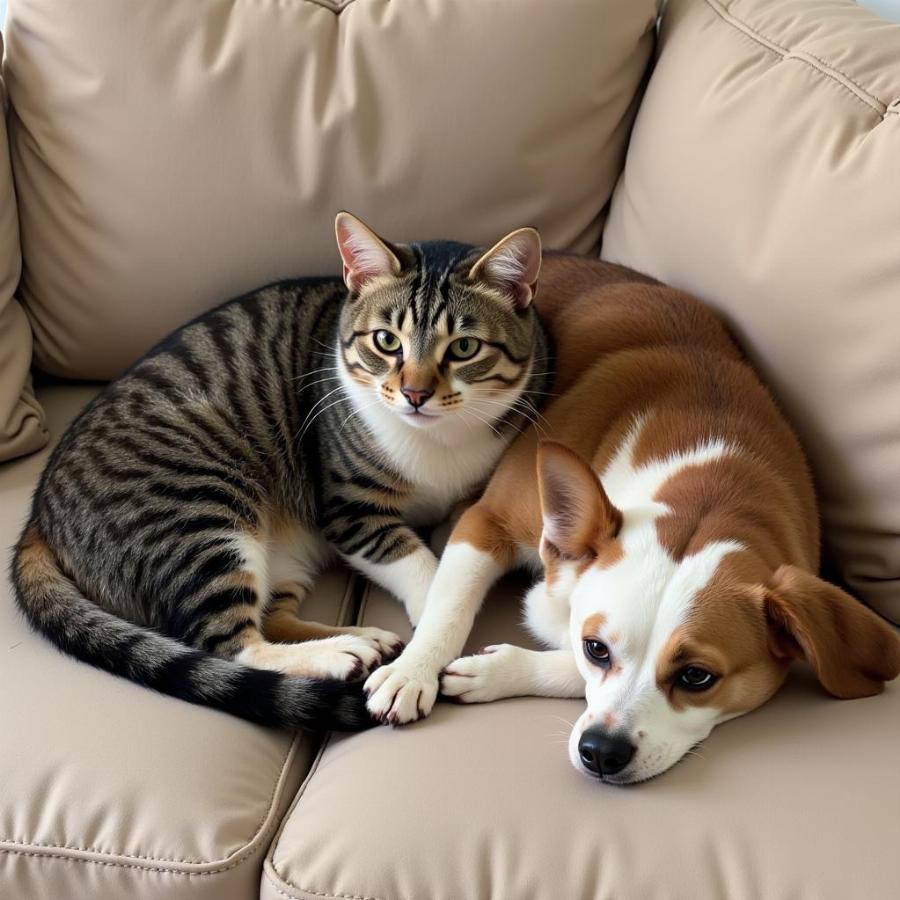Bringing a dog into a home that already has cats can be a wonderful experience, enriching the lives of both you and your furry companions. But it can also be a challenge, especially if you’re unprepared. The key to success lies in understanding the dynamics between cats and dogs and taking the necessary steps to ensure a smooth transition and a harmonious multi-species household.
Decoding Cat and Dog Behavior
Cats and dogs are different creatures with distinct communication styles and social cues. Dogs, being pack animals, are generally more social and outgoing. They use body language like tail wags, playful bows, and excited barks to interact. Cats, on the other hand, are more independent and communicate through subtler cues like meows, purrs, hisses, and even scent marking. Misinterpreting these signals can lead to misunderstandings and conflict.
Choosing the Right Dog Breed
Not all dog breeds are created equal when it comes to cohabitating with cats. Some breeds are known for their high prey drive, which can be a recipe for disaster if you have feline family members.
Here are some dog breeds that are generally considered cat-friendly:
- Golden Retriever: Known for their gentle nature and playful personality, Golden Retrievers often get along well with cats, especially if raised together.
- Bichon Frise: These fluffy, cheerful dogs are more likely to befriend a cat than chase it. Their smaller size also makes them less intimidating.
- Cavalier King Charles Spaniel: These affectionate and adaptable dogs thrive on companionship and can form strong bonds with feline housemates.
Introducing Your Dog to Your Cats
The initial introduction is crucial. Rushing the process can backfire and create lasting anxiety for both your cats and your dog.
- Gradual Introduction: Instead of a face-to-face meeting, start by keeping them separated. Allow them to sniff each other under the door or through their carriers to get acquainted with each other’s scents.
- Supervised Interactions: When you do introduce them, make it in a controlled environment under your watchful eye. Keep the dog leashed and allow the cats to approach at their own pace.
- Safe Spaces: Ensure your cats have designated safe zones, like high shelves or cat trees, where the dog can’t reach them. This allows them to observe and adjust without feeling threatened.
Essential Tips for a Harmonious Home
- Separate Feeding Areas: Provide separate eating spaces to prevent competition and potential food aggression.
- Plenty of Playtime: Engage your dog in plenty of physical and mental stimulation through walks, playtime, and training. A tired dog is less likely to pester a cat.
- Positive Reinforcement: Reward good behavior. Praise your dog for being calm around the cats and offer treats for gentle interactions.
- Patience is Key: Understand that building trust takes time. Be patient and consistent with your efforts and you’ll increase the chances of your furry family members coexisting peacefully and even becoming the best of friends.
 Cat and dog cuddling on a couch
Cat and dog cuddling on a couch
Can a Dog Help a Cat with Anxiety?
While it might seem counterintuitive, the presence of a well-adjusted dog can sometimes actually reduce anxiety in some cats. Dogs can bring a sense of stability and routine to a household, which can be calming for anxious felines. The dog’s presence can also encourage cats to be more active and playful, contributing to their overall well-being.
When to Seek Professional Help
If you observe constant tension, chasing, or aggression, consult a certified pet behaviorist or a veterinarian specializing in animal behavior. They can assess the situation and provide tailored guidance to address specific challenges.
Conclusion
Successfully integrating a dog into a home with cats requires careful planning, patience, and a deep understanding of both species. By taking the time to learn about their unique needs and following these tips, you can create a loving and harmonious home where your cats and dog can thrive together.
FAQs
1. Can any dog live with a cat?
While some breeds are more predisposed to being cat-friendly, any dog, with proper introduction and training, can potentially live harmoniously with a cat.
2. My dog keeps chasing my cat. What should I do?
This is a common issue. It’s crucial to never punish your dog for chasing. Instead, redirect their attention to a toy or command. Ensure your cat has escape routes and safe spaces.
3. How long does it take for a cat and dog to get used to each other?
Every situation is unique. Some cats and dogs become friends within days, while others might take weeks or even months.
4. My cat hisses at my dog. Is that normal?
Hissing is a cat’s way of communicating discomfort or setting boundaries. It’s normal, especially in the beginning. Give them space and let them adjust at their own pace.
5. Should I get a puppy or an older dog if I have cats?
Both have their pros and cons. Puppies are energetic and might be more likely to trigger a cat’s prey drive, while older dogs might be calmer but set in their ways. Consider your cat’s personality and your lifestyle.
Looking for more helpful tips and advice on dog breeds, care, and training? Visit [Beaut Dogs](https://beautdogs.com/) today!
Need personalized support for your furry friends? Email us at [email protected] for detailed and accurate answers to all your pet-related questions. Beaut Dogs is your trusted source for all things dog!